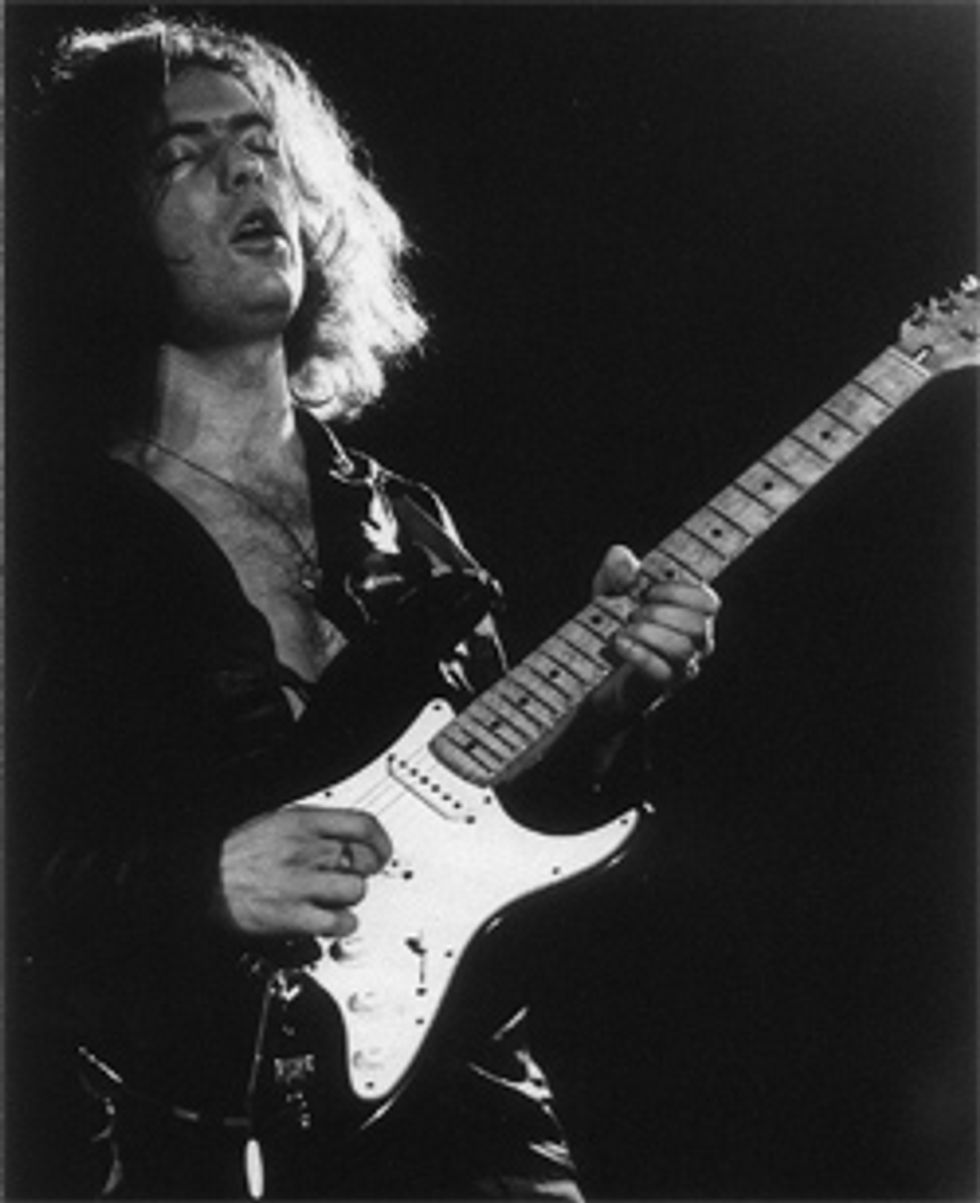The sound engineers at OEM Inc. have spent thousands of hours with the original masters of the most famous songs ever recorded. In a new monthly feature, we''ll be bringing you their findings. This month, they share the stories behind Deep Purple''s "Smoke on the Water."
| The sound engineers at OEM Inc. have spent thousands of hours with the original masters of the most famous songs ever recorded. They use them to create products like Jammit, an iPhone app that allows you to remix and play along with those original tracks. There are many, many things to learn from those original tracks. Through a partnership with Gearhead Communications, OEM Inc. engineers are sharing their discoveries exclusively with Premier Guitar readers in what we like to call Secrets of the Masters |
During every second of every minute of every hour of every day, somewhere in the world there’s a kid in a music store playing the lead riff to “Smoke on the Water.” The fact that Deep Purple’s 1972 rock anthem is part the repertoire of millions of guitarists old and new, if not the repertoire, is a testament to the song’s infectious, accessible groove. It is timeless, even when played incorrectly as most people play it. Like many legendary recordings, conflicting accounts of its creation can be augmented by media hype, fading memories, and of course, any drugs that may have been consumed before, during and after the recording. Today, we’ll focus on what we can corroborate from the original master multi-track tapes of “Smoke on the Water,” and piece together the real story.
Location, Location…
 Deep Purple’s sixth album, Machine Head,
was recorded under the watchful eye of
Martin Birch (Iron Maiden, Black Sabbath,
and early Fleetwood Mac) on 16-track 2"
tape at 15 inches per second with no noise
reduction. They recorded it over three weeks
in Montreux, Switzerland, using a mobile
studio truck rented from the Rolling Stones.
Remember, back in those days location
recording wasn’t as simple as throwing your
laptop and MBox into the back of your Prius!
Let this tale serve as a reminder that it’s good
to keep your recordings adventurous!
Deep Purple’s sixth album, Machine Head,
was recorded under the watchful eye of
Martin Birch (Iron Maiden, Black Sabbath,
and early Fleetwood Mac) on 16-track 2"
tape at 15 inches per second with no noise
reduction. They recorded it over three weeks
in Montreux, Switzerland, using a mobile
studio truck rented from the Rolling Stones.
Remember, back in those days location
recording wasn’t as simple as throwing your
laptop and MBox into the back of your Prius!
Let this tale serve as a reminder that it’s good
to keep your recordings adventurous!Master Tapes Don’t Lie
For most of us, Ian Gillan’s lyrics on “Smoke on the Water” have already documented the backstory of Machine Head very well. A fire broke out during a Frank Zappa concert at a casino in Montreux, thwarting the band’s plans to record there. This forced the band to record in the “empty cold and bare” Grand Hotel instead. Although much of the album was indeed recorded at the hotel, the basic tracks for “Smoke” were tracked at the nearby Pavilion Theatre. As the story goes, the band had set up and recorded a few takes before police were called on a noise complaint. After getting shut down, they would settle into the seasonally-vacant Grand Hotel.
Soloing the original “Smoke” tracks today may be the closest thing there is to going back in time to witness Deep Purple tracking this historic performance. When listening to and comparing the stereo ambient room tracks of “Smoke in the Water” to the other songs on Machine Head, I can distinctly hear a larger room than what was captured in the hallway of the hotel. It is clear that the final take of “Smoke” was recorded before the police shut them down at the Pavilion. Furthermore, there is no evidence on the tracks that could substantiate the claim that the fuzz broke down the session immediately following the take, as some stories have insisted. Even following the short vamp that happens after the fade, each instrument peels away to several seconds of room silence only to reveal a barely audible “… have a listen?” uttered by one of the band members or Birch on the talkback.
Sometimes it’s what you don’t hear that can be more interesting: upon further scrutiny of these tell-all room tracks, healthy amounts of bleed from Ritchie Blackmore’s rhythm guitar seem to blend organically with Jon Lord’s overdriven organ while Ian Paice’s drums seemed smaller and distant off to the right. Unlike all the other songs tracked at the hotel, there is no bass bleed into these ambient microphones, leading me to believe that Birch was able to sufficiently isolate Roger Glover’s bass cabinet from the main tracking room. There is, however, enough bleed and band ambience in the bass track to confirm it was not an overdub. It was, in fact, played live with the others. In all cases, the direct instrument tracks absolutely match up with these ambient ones, proving that there were no punch-ins or individual fixes to any of the performances.
More Blackmore
 Ritchie Blackmore. Photo by Neil Zlozower |
Chillin’ Like Gillan
Guitar outtakes weren’t the only unused tracks residing on the multi-track tape. Ian Gillan had a scratch vocal that sounded more like a guide track than an actual contender for the final mix. There were a few places that sounded almost spoken rather than sung and the performance was definitely pitchier than the master take. Aside from several instances of different vocal phrasings, there was a variance in Ian’s reference to Claude Nobs (founder of the Montreux Jazz Festival) who saved the lives of concertgoers in the casino fire. On this track he sang, “Dear Claude was running in and out pulling people out the ground,” as opposed to the familiar, “Funky Claude was running in and out pulling kids out the ground,” as can be heard in the final version. There were also more of Ian’s signature bluesy adlibs past the point of where the singing stopped on the original version; these adlibs kept going to where the song fades. It’s in this section that we also heard Gillan say, “Break a leg, Frank.” It was previously believed that he first dropped that famous line months later while performing the song live on the BBC. The line references Zappa actually breaking his leg after an unruly fan bum rushed him off a London stage just days after the the Montreux fire.
Learning More by Listening
Well, we may not have unearthed some classic rock conspiracy here, but perhaps we have a better understanding of what went into Deep Purple’s biggest hit, “Smoke on the Water.” We may never see the Gillan-Lord-Blackmore- Glover-Paice lineup on stage again, but no clash of egos or creative differences could ever diminish the spirit captured in Montreux, Switzerland, December 1971—when rock n’ roll history was made despite all kinds of adversity.
To see/hear how you can play along to and make new mixes of “Smoke on the Water” and other songs from the original multi-track masters, check out www.jammit.com
 Frank Gryner is a multi-platinum engineer whose
credits include bands like A Perfect Circle, Matrix
Soundtracks, Rob Zombie, and Tommy Lee. Frank’s
technical expertise in audio system design has been
applied to location studios for the likes of Filter, Perry
Farrell and John Paul Jones.
Frank Gryner is a multi-platinum engineer whose
credits include bands like A Perfect Circle, Matrix
Soundtracks, Rob Zombie, and Tommy Lee. Frank’s
technical expertise in audio system design has been
applied to location studios for the likes of Filter, Perry
Farrell and John Paul Jones.